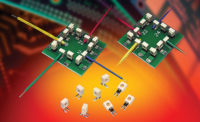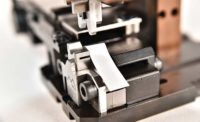It goes without saying that manufacturers want the highest possible quality at the lowest possible cost. These days, everyone is trying to do more with less.
This is as true for automatic crimping presses as it is for any other product. Conventional designs use thick, steel side-plates or a cast frame in conjunction with a motor and gearbox combination. These proven designs work well. However, they are expensive to make. The high manufacturing costs are due to the high tolerance requirements for many of the components used in conventional crimping presses. The performance of conventional presses also degrades over time due to the design of the motor and gearbox.
Recently, Schleuniger introduced a radical new design in automatic crimping presses. The new design created a compact, efficient and cost-effective press with high process capability and durability. The design is simple, easy to manufacture, and easy to set up and maintain. In addition, the new design takes into consideration application flexibility and integrated crimp-force monitoring.
The frame is made of formed sheet metal rather than solid pieces of heavy steel or a cast frame. Instead of the conventional motor and gearbox combination, a direct belt-drive system is used. A spring mechanism is incorporated into the press ram, providing excellent consistency and durability. Finally, the new press design is adjustable and easily accommodates the wide range of crimping applicators on the market.
Frame Design
Comparing the different frame designs explains why we chose the formed sheet metal design. Cast frames are inexpensive and rugged. However, volumes must be high for the initial investment costs to be justified. Welded frame constructions are also durable, but the manufacturing process is relatively expensive.
Similarly, using heavy, solid steel side-plates has been proven as a durable design. Unfortunately, the manufacturing process for these plates is expensive, since they require milling and plating processes. Furthermore, we determined that the solid steel side-plate construction is overkill for forces up to 20 kilonewtons. The force load distribution over the side-plates does not require the same thickness throughout their entire width to achieve the desired results for the target applications.
The forces exerted by the crimping process on the side-plates are opposing from front to back. High, outward forces are exerted on the front of the side plates (closest to the applicator). In contrast, lower inward forces are exerted on the back of the side plates. Between the front and the back, the forces cancel. Therefore, it is not necessary to have the same support structure—in other words, the same side-plate thickness—throughout the entire plate. The formed steel side plates support these forces where they are exerted, in the front and the back.
At first, building a crimping press out of formed sheet metal might seem to be a radical concept. However, it has been used successfully in other industries. One example is truck frames. Truck frames are made of formed sheet metal, and they support forces far greater than those realized on a crimping press.
Drive Design
The traditional gearmotor drive design for crimping presses is effective, yet expensive. The gearbox, shaft and ram coupling must be aligned perfectly to prevent premature bearing wear. Tolerances need to be tight, and that means higher prices. Furthermore, if the parts are installed incorrectly, components will wear prematurely. Finally, mechanical parts inevitably wear over time. After millions of cycles, excess play begins to degrade performance.
The challenge in rethinking the crimping press was to create a machine that could achieve the same or better durability and precision as the traditional gearbox, but with a simpler, lower cost design.
The implementation of a belt drive makes the design much simpler and, as a result, much easier to manufacture and assemble. Tolerances are less critical, because the flexible timing belt will compensate. Because of the looser tolerances, parts are less expensive. An added benefit of this design is that servicing is much easier as well.
A Spring Was the Key
How do you get precision from a system that has relaxed tolerances? It is true that relaxed tolerances inherently mean that there is more play in the system. However, the answer was quite simple: a spring. The key to our new design is a spring mechanism that compresses all of the excess play at the bottom of the crimping stroke, where the precision is needed most. This simple spring assembly also provides better process capability results. Throughout the life of the press, the spring mechanism continues to remove excess play as parts wear. Machine capability and precision remain consistent for a much longer period of time, therefore extending the life of the machine.
Through external and long-term testing, the new design concepts have proven to provide performance and durability over an extended period of time.




